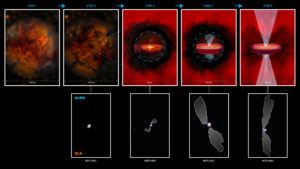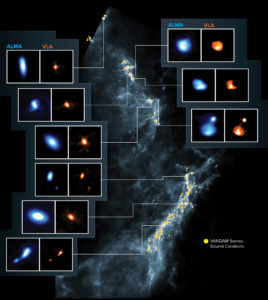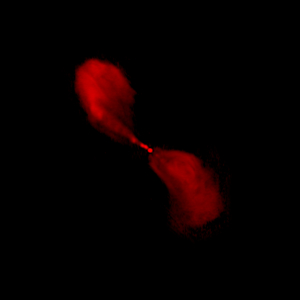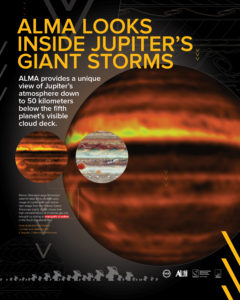NGC 6240 as seen with ALMA. The molecular gas is blue and the black holes are the red dots. This image provides the sharpest view yet of the molecular gas around the black holes in this merging galaxy.


The formation of protostars
This schematic shows a proposed pathway (top row) for the formation of protostars, based on four very young protostars (bottom row) observed by VLA (orange) and ALMA (blue). Step 1 represents the collapsing fragment of gas and dust. In step 2, an opaque region starts to form in the cloud. In step 3, a hydrostatic core starts to form due to an increase in pressure and temperature, surrounded by a disk-like structure and the beginning of an outflow. Step 4 depicts the formation of a class 0 protostar inside the opaque region, that may have a rotationally supported disk and more well-defined outflows. Step 5 is a typical class 0 protostar with outflows that have broken through the envelope (making it optically visible), an actively accreting, rotationally supported disk. In the bottom row, white contours are the protostar outflows as seen with ALMA.

Protostars in Orion Molecular Clouds
This image shows the Orion Molecular Clouds, the target of the VANDAM survey. Yellow dots are the locations of the observed protostars on a blue background image made by Herschel. Side panels show nine young protostars imaged by ALMA (blue) and the VLA (orange).

VANDAM survey
ALMA and the VLA observed more than 300 protostars and their young protoplanetary disks in Orion. This image shows a subset of stars, including a few binaries. The ALMA and VLA data complement each other: ALMA sees the outer disk structure (visualized in blue), and the VLA observes the inner disks and star cores (orange).

Centaurus A in Radio
An active galaxy at a distance of 10 million light years from Earth.

ALMA Peers into the Turbulent Atmosphere of Jupiter
Swirling clouds, big colorful belts of sinking gas, and giant storms. What can radio telescopes detect below the visible clouds of Jupiter? What is causing the many storms and eruptions that we see hovering around the planet? The Atacama Large Millimeter/submillimeter Array (ALMA), observing in radio wavelengths, gives us the first view of Jupiter’s atmosphere down to fifty kilometers below the planet’s three different cloud layers, or decks.





